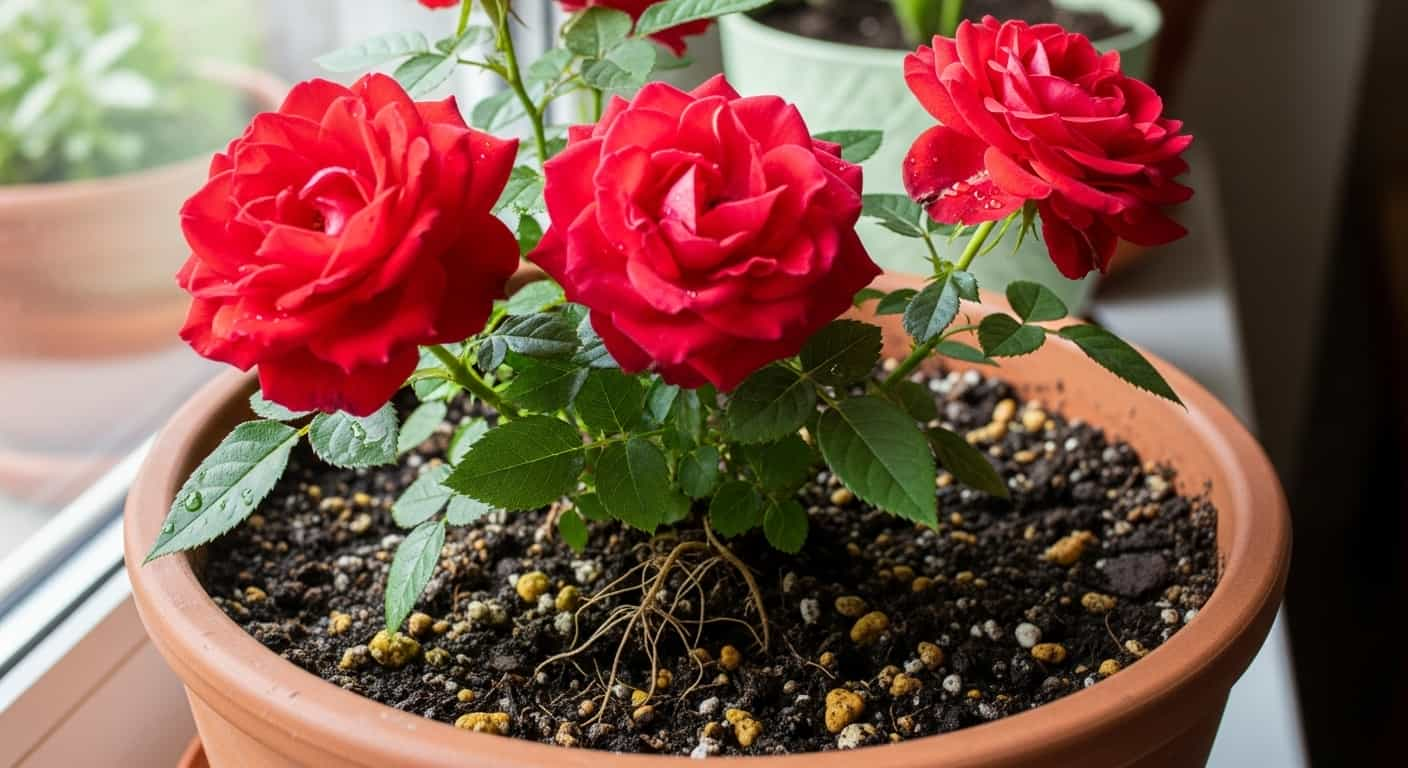Bringing the classic beauty of roses indoors is a delightful way to brighten any space. These elegant plants, however, can seem finicky to care for, especially when it comes to watering. More indoor roses are lost to improper watering than to any other cause. The delicate balance between providing enough moisture for lush growth and avoiding the fatal mistake of overwatering can feel like a tightrope walk. So, how much is too much?
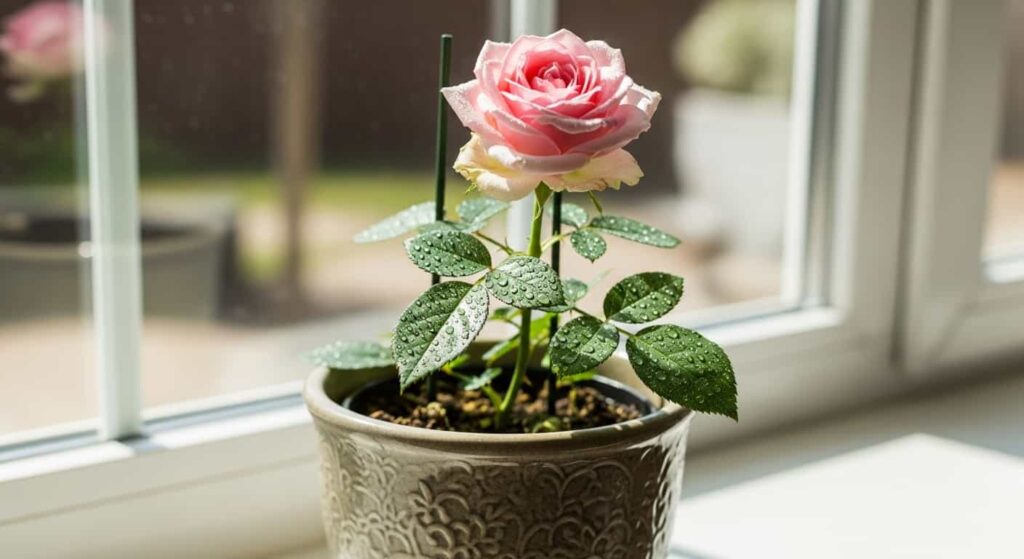
Understanding the precise water needs of your indoor roses is the cornerstone of successful rose care. Unlike plants in a garden, which benefit from natural rainfall and deep soil, a potted rose is completely dependent on you. Its confined environment makes it highly susceptible to the dangers of both too much and too little water. A rigid, one-size-fits-all watering schedule is often the fastest path to an unhealthy plant.
This comprehensive guide will demystify the art and science of watering indoor roses. We will explore the critical signs of both overwatering and underwatering, teach you reliable methods for checking soil moisture, and outline the key factors that influence your plant’s thirst. You’ll learn how to develop a watering routine that adapts to your rose’s specific needs, ensuring it has the perfect hydration to support vibrant leaves and stunning, continuous blooms.
The Dangers of Imbalance: Overwatering vs. Underwatering
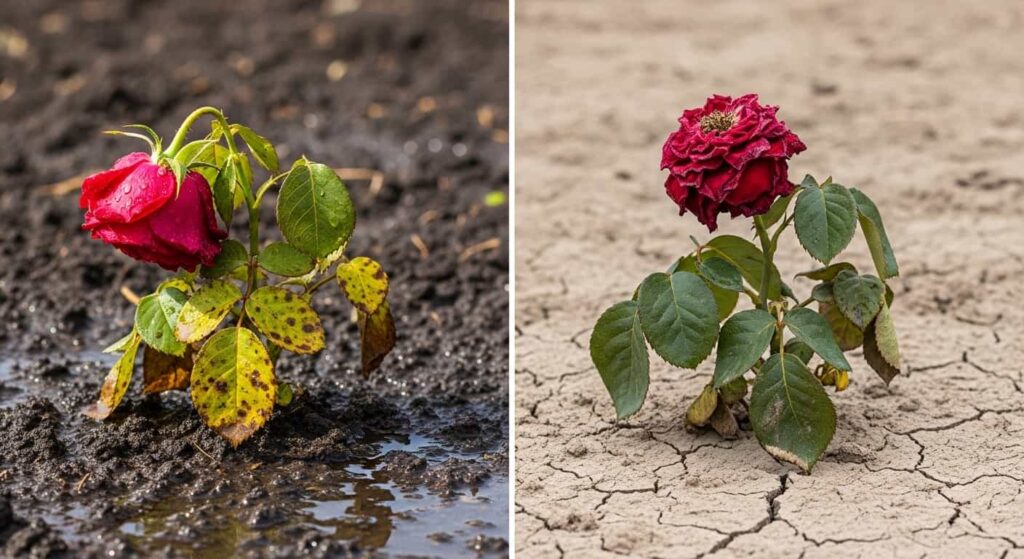
Water is essential for a rose’s survival. It transports nutrients from the soil to the leaves, facilitates photosynthesis, and maintains the turgor pressure that keeps stems and leaves firm. However, both an excess and a deficit of water can have dire consequences. Recognizing the symptoms is the first step toward correcting the problem.
The Silent Killer: Recognizing the Signs of Overwatering
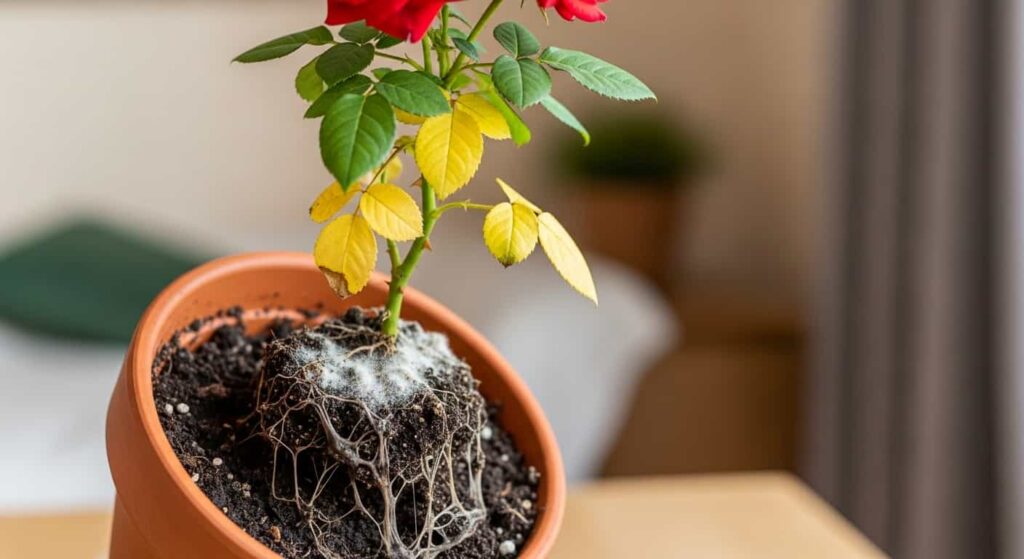
Overwatering is the most common and most dangerous mistake in indoor rose care. When soil is constantly saturated, the tiny air pockets that roots need to breathe are filled with water. This suffocates the roots, leading to a condition called root rot, which is often fatal if not caught early.
Key Symptoms of Overwatering:
- Yellowing Leaves (Bottom-Up): One of the most classic signs is chlorosis, or yellowing leaves. In the case of overwatering, this typically starts with the lower, older leaves and progresses up the plant. The leaves may turn a soft, pale yellow and feel limp before they fall off.
- Wilted, Drooping Appearance: This is a confusing symptom because underwatered plants also wilt. However, an overwatered plant wilts even when the soil is wet. The plant droops because the damaged, suffocating roots can no longer absorb water, leading to a state of “functional drought.”
- Stunted Growth and Lack of New Shoots: If your rose’s growth has stalled, and it isn’t producing new leaves or flower buds, its roots may be struggling in waterlogged soil. The plant is directing all its energy toward survival, not growth.
- Foul Odor from the Soil: Healthy soil has a fresh, earthy smell. If you notice a sour, swampy, or rotten egg-like smell coming from the pot, it’s a strong indicator that anaerobic bacteria are thriving in the oxygen-deprived soil, and root rot has begun.
- Mold or Fungus on the Soil Surface: A perpetually damp soil surface is an ideal breeding ground for mold, mildew, and fungus gnats. While not always directly harmful to the plant, their presence signals that the soil is staying wet for too long.
- Brown, Mushy Roots: If you suspect overwatering, the ultimate test is to check the roots. Gently slide the plant out of its pot. Healthy roots are firm, pliable, and typically white or light tan. Rotted roots will be dark brown or black, feel soft and mushy to the touch, and may even fall apart easily.
The Thirsty Plant: Recognizing the Signs of Underwatering
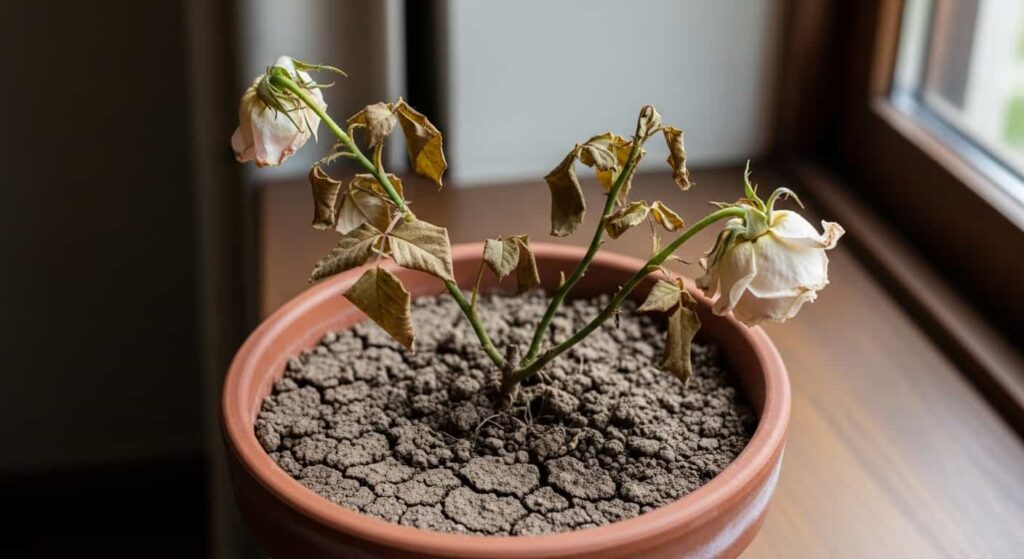
While less common, underwatering can also cause significant stress and damage to your indoor rose. When a plant doesn’t receive enough water, it cannot perform essential life functions, leading to a rapid decline in health.
Key Symptoms of Underwatering:
- Wilted and Drooping Leaves: This is the most immediate and obvious sign. The plant’s leaves and stems will lose their rigidity and droop downwards as the cells lose turgor pressure.
- Crispy, Brown Leaf Edges: When a plant is consistently dehydrated, the tips and edges of the leaves, which are furthest from the roots, will often be the first to dry out, turning brown, brittle, and crispy.
- Yellowing Leaves (All Over): Unlike the bottom-up yellowing of an overwatered plant, an underwatered rose may develop yellow leaves more uniformly throughout the plant as it sheds foliage to conserve moisture.
- Bud and Flower Drop: Before they even have a chance to open, flower buds may dry up and fall off. Existing flowers will wilt quickly and have a much shorter lifespan.
- Dry, Compacted Soil: The soil in the pot will feel bone-dry to the touch. It may even pull away from the sides of the pot, creating a visible gap. When you try to water it, the water might run straight through without being absorbed.
How to Water Your Indoor Roses Correctly
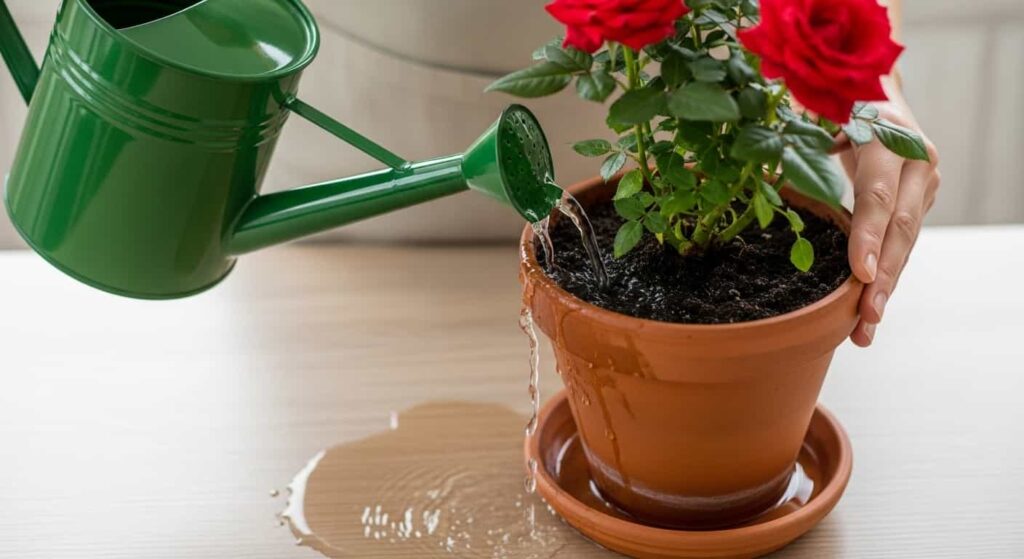
The golden rule of watering indoor roses is simple: water deeply but infrequently. The goal is to thoroughly saturate the root ball and then allow the soil to dry out partially before watering again. This approach encourages strong root development and prevents the constant dampness that leads to root rot.
Step 1: Ditch the Schedule and Check the Soil
The biggest mistake you can make is watering on a fixed schedule, such as every Saturday. A rose’s water needs change constantly based on the season, room temperature, humidity, and its growth cycle. Instead of relying on the calendar, learn to read your plant and its soil.
The Finger Test: This is the most reliable and time-tested method. Insert your index finger into the soil up to your second knuckle (about two inches deep).
- If the soil feels damp or moist at your fingertip, do not water. Wait another day or two and check again.
- If the soil feels dry at your fingertip, it’s time to water.
Other Methods for Checking Moisture:
- The Lift Test: After you become familiar with your potted rose, you can gauge its water needs by weight. A pot with dry soil will feel noticeably lighter than one with well-watered soil.
- A Moisture Meter: These inexpensive tools can be helpful, especially for beginners. You insert the probe into the soil, and the meter gives you a reading of the moisture level. However, always use it as a guide and confirm with the finger test, as meters can sometimes give inaccurate readings.
Step 2: The Art of Thorough Watering
Once you’ve determined it’s time to water, follow this technique to ensure the entire root system gets a good drink.
- Use Room Temperature Water: Water that is too cold or too hot can shock the plant’s root system. Lukewarm or room temperature water is ideal.
- Water the Soil, Not the Leaves: Apply water directly to the soil surface, avoiding the foliage as much as possible. Wet leaves can encourage fungal diseases like black spot and powdery mildew.
- Water Slowly and Evenly: Pour water slowly over the entire soil surface until it begins to run out of the pot’s drainage holes. This ensures that all parts of the root ball are evenly moistened, preventing dry pockets.
- Let it Drain Completely: This is a crucial step. Allow the pot to sit for 10-15 minutes so all excess water can drain away freely.
- Empty the Saucer: Never, ever let your rose pot sit in a saucer full of water. This is the equivalent of forcing your plant to stand in a puddle and is a direct invitation to root rot. Always discard the excess water that collects in the drainage tray.
What About Bottom Watering?
Bottom watering is an alternative method where the pot is placed in a tray of water, allowing the soil to absorb moisture from the bottom up through the drainage holes. This can be an effective technique, especially if your soil has become very dry and compacted.
How to Bottom Water:
- Fill a sink or basin with a few inches of room-temperature water.
- Place your rose pot in the water.
- Let it sit for 15-30 minutes, or until the top surface of the soil feels moist.
- Remove the pot from the water and let it drain completely for another 15 minutes before returning it to its saucer.
While effective, it’s good practice to occasionally water from the top (perhaps once a month) to help flush out any mineral salts that can accumulate in the soil from fertilizers.
Factors That Influence Your Rose’s Water Needs
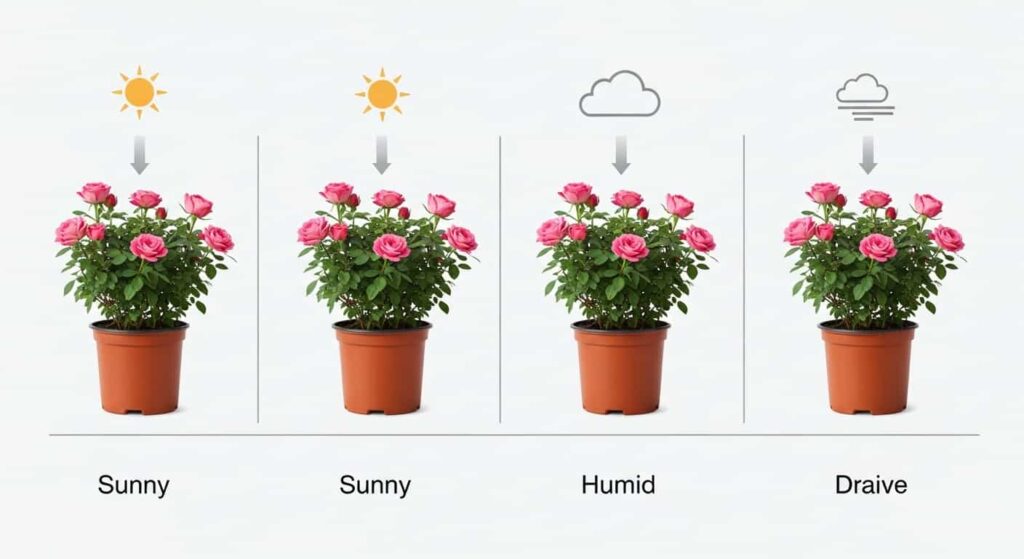
Understanding why your rose’s watering needs fluctuate will help you become a more intuitive and successful plant parent. Several environmental and plant-specific factors play a role.
- Pot Size and Material: A small pot holds less soil and will dry out much faster than a large one. Porous materials like terracotta or unglazed ceramic “breathe,” allowing moisture to evaporate through the sides, and will require more frequent watering than non-porous plastic or glazed pots.
- Light Exposure: A rose sitting in a bright, sunny window will use water much more quickly for photosynthesis and transpiration than a rose in a lower-light location.
- Temperature and Humidity: Higher temperatures and lower humidity cause water to evaporate from the soil and transpire from the leaves more rapidly. You will need to water more often in a hot, dry room.
- Season and Growth Cycle: Plants, including indoor roses, have natural growth cycles. During the active growing season (spring and summer), they are producing new leaves and flowers and will need significantly more water. In the fall and winter, their growth slows, and they enter a semi-dormant period, requiring much less water.
- Soil Mix: The composition of your potting soil has a huge impact. A well-draining mix with ingredients like perlite and pine bark will dry out faster than a dense, heavy soil that retains a lot of water.
Rescuing Your Rose: What to Do in an Emergency
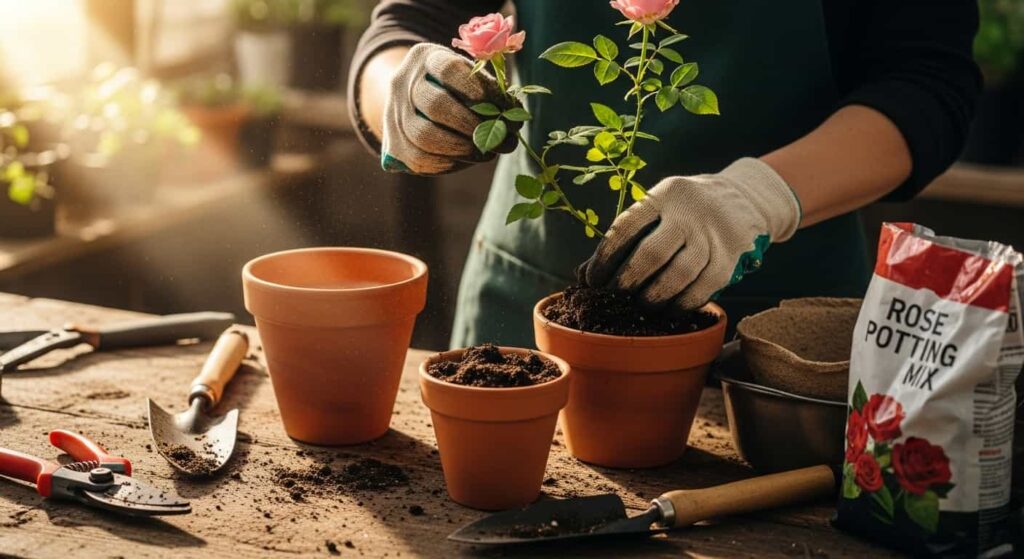
Even with the best care, mistakes can happen. Here’s how to take corrective action if you’ve severely overwatered or underwatered your rose.
How to Save an Overwatered Rose
- Stop Watering Immediately: Do not add any more water to the saturated soil.
- Improve Air Circulation: Move the plant to a spot with better airflow to help the soil dry out faster. You can also gently poke a few holes in the soil with a chopstick to introduce air into the root zone.
- Emergency Repotting (for severe cases): If the soil is completely waterlogged and you suspect root rot, you may need to perform an emergency repot.
- Carefully remove the plant from its pot.
- Gently rinse the old, soggy soil from the roots.
- Inspect the roots. Using clean, sharp scissors, trim away any roots that are black, brown, and mushy. Healthy roots are firm and white.
- Repot the plant in a clean pot (perhaps one size smaller if you removed a lot of roots) using fresh, dry, well-draining potting mix.
- Water very lightly and wait for signs of new growth before resuming a normal watering routine.
How to Revive an Under-Watered Rose
Reviving a dehydrated plant is often easier than saving an overwatered one, provided it hasn’t completely dried out.
- A Deep Soak: The best way to rehydrate severely dry soil is with a thorough soak. Place the entire pot in a sink or bucket of lukewarm water. Let it sit for 30-60 minutes, allowing the soil to slowly and completely reabsorb moisture.
- Drain and Monitor: After the soak, let the pot drain fully. The plant may still look wilted for a few hours, but it should start to perk up.
- Prune Damage: Trim away any leaves or stems that have become completely brown and crispy, as they will not recover.
- Adjust Your Routine: Use this as a learning experience. Check the soil more frequently to prevent it from getting too dry in the future.
By moving away from a rigid schedule and learning to listen to your plant, you can master the art of watering. Providing the right amount of water at the right time is the most important skill in indoor rose care, and it is the key that will unlock the door to a healthy, thriving plant covered in magnificent blooms.

